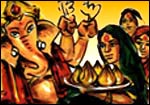

|
|
|
|
| HOME | TRAVEL | TRAVELOG | |||
| September 5, 1997 |
 Sweets for a Tuskered Deity ... honouring Ganapati on his feast day Vimla Patil
Ganesha, the remover of all obstacles, is the elephant-headed son of Shiva and Parvati. He represents wisdom, goodwill and most important, the art of living a balanced life. There are many myths which describe how he came to have an elephant head on a rotund body. The story goes that one day in Shiva's absence, before her bath, Parvati fashioned the image of a boy from clay. And with her divine powers, she poured life into him and commanded him to guard her home while she was gone. Just then Shiva returned and was stopped by the boy. Shiva, in anger, cut off the boy's head. To appease the inconsolable Parvati, the boy's head was recreated by Shiva, with the first head that was available, which happened to be that of an elephant. Parvati fought all the gods who refused to recognise her son and vanquished them. As an agreement of surrender after their defeat, the gods consented to Parvati's condition that her son Ganesha would have the honour of being worshipped first before all gods. He would be the beginning of all auspicious events. In the philosophical context, Ganesha demonstrates that an elephant and a mouse -- which is always seen with him -- can live happily together, although they are opposite in form and nature. Ganesha is also evidence that a fat, rotund person like him can still be a supreme connoisseur of dance and music. In fact he proves that the world is full of opposites which exist peacefully side by side. Ganesha has inspired painters, sculptors, musicians and dancers for a millennium. Though in reality, he could be considered ugly, every Indian thinks him to be beautiful and loves him with devotion. The form of Ganesha is equated with the symbol om, which stands for the cosmic music or origin of the universe, pranava. Thus Ganesha is depicted as pink, corpulent, potbellied god, always with sweetmeats in his hands. His rotund body shows his fondness for good food and he is therefore loved specially by children. His favourite sweet, called modak, is made and served to guests on Ganesha Chaturthi, which comes every year in August or September. Almost at the end of the festive four months of July, June, August and September -- which are known as Chaturmas -- comes the festival honouring the birth of Ganesha. The ruling deity of arts and good life, he naturally brings a feast of good food with him. Thousands of homes, especially in Maharashtra, bring clay idols of the deity home to be worshipped. Community idols are huge and artistically sculpted. For ten days the festivities continue. Then the idols are immersed in the sea, or a river or a lake, with shouts of fond farewell to him. The merrymakers and devotees return home with the promise from him that he will return again the next year, to bless the world and bring prosperity and peace to mankind. Vimla Patil is a master cook and the author of several books. She was the editor of Femina.
|
|
|
|
|
HOME |
NEWS |
BUSINESS |
CRICKET |
MOVIES |
CHAT
INFOTECH | TRAVEL | LIFE/STYLE | FREEDOM | FEEDBACK |
|